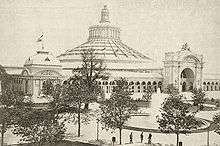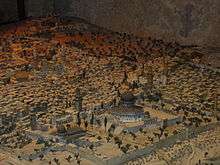1873 Vienna World's Fair
| 1873 Vienna | |
|---|---|
 The Rotunde, centre of the exhibition | |
| Overview | |
| BIE-class | Universal exposition |
| Category | Historical Expo |
| Name | Weltausstellung |
| Motto | Kultur und Erziehung (English: Culture and Education) |
| Building | Rotunde |
| Area | 233 Ha |
| Visitors | 7,255,000 |
| Location | |
| Country | Austria-Hungary |
| City | Vienna |
| Venue | Prater |
| Coordinates | 48°12′58″N 16°23′44″E / 48.21611°N 16.39556°E |
| Timeline | |
| Opening | 1 May 1873 |
| Closure | 31 October 1873 |
| Universal expositions | |
| Previous | Exposition Universelle (1867) in Paris |
| Next | Centennial Exposition in Philadelphia |
Weltausstellung 1873 Wien (English: World Exposition 1873 Vienna) was the large world exposition that was held in 1873 in the Austria-Hungarian capital of Vienna. Its motto was Kultur und Erziehung (English: Culture and Education).
There were almost 26,000 exhibitors[1] housed in different buildings that were erected for this exposition, including the Rotunde (English: Rotunda), a large circular building in the great park of Prater designed by the Scottish engineer John Scott Russell. The Rotunde was destroyed by fire on 17 September 1937.
The Russian pavilion had a naval section designed by Viktor Hartmann. Exhibits included models of the Port of Rijeka[2] and the Illés Relief model of Jerusalem.[3]
Ottoman pavilion
Osman Hamdi Bey, an archaeologist and painter, was chosen by the Ottoman government as commissary of the empire's exhibits in Vienna. He organized the Ottoman pavilion with Victor Marie de Launay, a French-born Ottoman official and archivist, who had written the catalogue for the Ottoman Empire's exhibition at the 1867 Paris World's Fair.[4] The Ottoman pavilion, located near the Egyptian pavilion (which had its own pavilion despite being a territory of the Ottoman Empire),[5] in the park outside the Rotunde, included small replicas of notable Ottoman buildings and models of vernacular architecture: a replica of the Sultan Ahmed Fountain in the Topkapı Palace, a model Istanbul residence, a representative Turkish bath, a cafe, and a bazaar.[6] The 1873 Ottoman pavilion was more prominent than its pavilion in 1867. The Vienna exhibition set off Western nations' pavilions against Eastern pavilions, with the host, the Austro-Hungarian Empire, setting itself at the juncture between East and West.[5] A report by the Ottoman commission for the exhibition expressed a goal of inspiring with their display "a serious interest [in the Ottoman Empire] on the part of the industrialists, traders, artists, and scholars of other nations...."[5]
The Ottoman pavilion included a gallery of mannequins wearing the traditional costumes of many of the varied ethnic groups of the Ottoman Empire. To supplement the cases of costumes, Osman Hamdi and de Launay created a photographic book of Ottoman costumes, the Elbise-i 'Osmaniyye (Les costumes populaires de la Turquie), with photographs by Pascal Sébah. The photographic plates of the Elbise depicted traditional Ottoman costumes, commissioned from artisans working in the administrative divisions (vilayets) of the Empire, worn by men, women, and children who resembled the various ethnic and religious types of the empire, though the models were all found in Istanbul. The photographs are accompanied by texts describing the costumes in detail and commenting on the rituals and habits of the regions and ethnic groups in question.[5]
Gallery
 Main entrance to the fair with the Rotunde behind
Main entrance to the fair with the Rotunde behind Naval section of the Russian pavilion
Naval section of the Russian pavilion The Illés Relief
The Illés Relief Exhibition hall for art and oriental
Exhibition hall for art and oriental Swedish folk costumes displayed at the exposition
Swedish folk costumes displayed at the exposition
Impact on Vienna
The exhibition led to an intensive building activity in the years before. The new train station to Germany Nordwestbahnhof was completed just in time, for example.
References
- ↑ Lowe, Charles. Four national exhibitions in London and their organiser. With portraits and illustrations (1892). London, T. F. Unwin. p. 28. Retrieved April 5, 2012.
- ↑ "PATCHing the city 09". City of Rijeka. 2009. p. 6. Archived from the original (PDF) on March 19, 2012. Retrieved November 27, 2013.
- ↑ "Tower of David Museum of the History of Jerusalem | Model of Jerusalem in the 19th Century". Towerofdavid.org.il. Archived from the original on December 3, 2013. Retrieved November 27, 2013.
- ↑ Trencsényi, Balász; Kopečk, Michal (2007). "Osman Hamdi Bey and Victor Marie de Launay: The Popular Costumes of Turkey in 1873". Discourses of Collective Identity in Central and Southeast Europe (1770–1945). National Romanticism: Formation of National Movements. II. Budapest; New York: Central European University Press. pp. 174–180.
- 1 2 3 4 Ersoy, Ahmet (2003). "A Sartorial Tribute to Late Tanzimat Ottomanism: The Elbise-i 'Osmaniyye Album". Muqarnas. 20: 187–207. JSTOR 1523332.
- ↑ Çelik, Zeynep (1992). "Islamic Quarters in Western Cities: Universal Exposition of 1873, Vienna". Displaying the Orient: Architecture of Islam at Nineteenth-Century World's Fairs. Berkeley, Los Angeles, Oxford: University of California Press. ISBN 0520074947.
External links
- Official website of the BIE

- The Rotunda of the 1873 Vienna International Exhibition
- Images from the exhibition